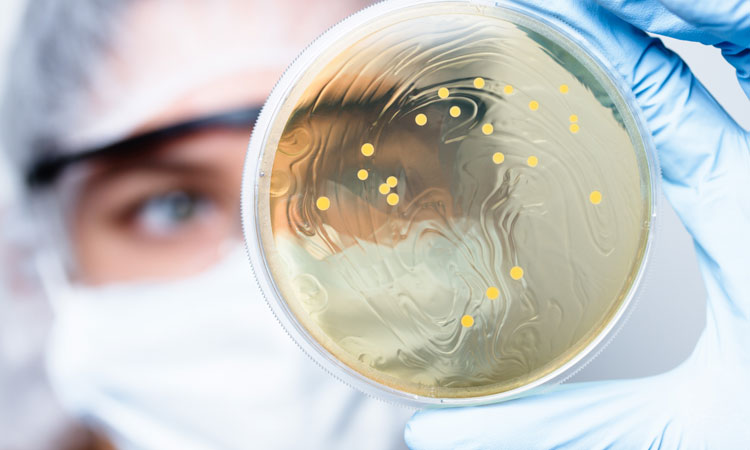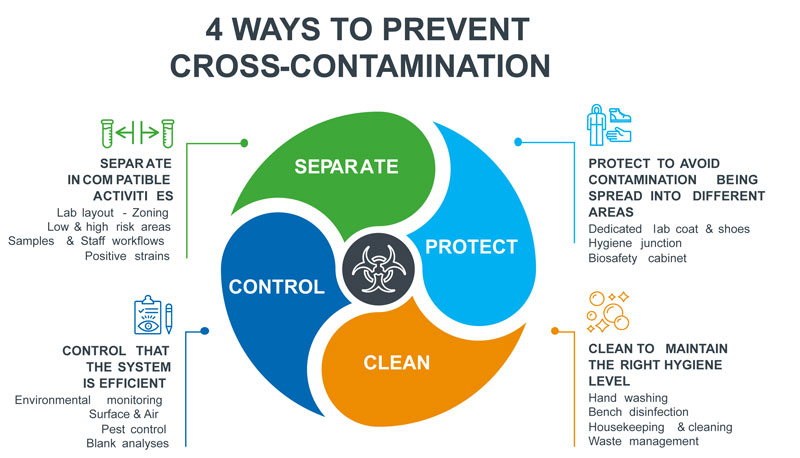Reduce the risk of cross-contamination
- Like
- Digg
- Del
- Tumblr
- VKontakte
- Buffer
- Love This
- Odnoklassniki
- Meneame
- Blogger
- Amazon
- Yahoo Mail
- Gmail
- AOL
- Newsvine
- HackerNews
- Evernote
- MySpace
- Mail.ru
- Viadeo
- Line
- Comments
- Yummly
- SMS
- Viber
- Telegram
- Subscribe
- Skype
- Facebook Messenger
- Kakao
- LiveJournal
- Yammer
- Edgar
- Fintel
- Mix
- Instapaper
- Copy Link
Posted: 18 June 2021 | Antoine Cabon, Jerome Combrisson | No comments yet
Two experts from Mars and Danone offer expert guidance for improving routine microbiology lab management to ensure accurate analytical results.


Microbiological cross-contamination has contributed to several well documented false positive events, which have led to time, resources and money being wasted. In the most extreme cases, unnecessary product recalls have been actioned, food has been wasted and brand reputation negatively impacted. These events largely go publicly unreported; however, behind the scenes, they create a significant drain on resources due to the need to thoroughly investigate right back to the root cause, provoking immense concern for all parties involved.
What does testing involve?
When working in a microbiology testing laboratory, aseptic techniques and correct segregation of activities are fundamental to preventing such cross‑contamination events. This holds true whether traditional microbiology or molecular-based assays are being employed.
Commercial testing laboratories operate in a highly competitive market and the vast majority already work to high standards. For example, it is becoming increasingly expected that labs are ISO/IEC 17025:2017 (general requirements for the competence of testing and calibration laboratories) accredited.1
Currently, laboratory standards such as ISO 17025 and ISO 72182 cannot specify every precaution in all circumstances to safeguard against cross‑contamination of samples. Both standards aim to set out ‘what’ must be achieved and not necessarily the ‘how’. Therefore, in an effort to ensure cross‑contamination events do not occur, many companies have developed their own laboratory standards to complement ISO 17025 and ISO 7218.
This article highlights some of the major sources of cross-contamination to be aware of, as well as the control measures defined and required by Danone and Mars in their effort to jointly improve standards in their laboratory networks.
Examples of cross contamination
In 2013, a finished product sample tested positive for Salmonella Hadar in a routine testing lab in Europe. Prior to this, the lab had received a proficiency test sample that contained NCTC 9877 Salmonella Hadar. Whole genome sequencing (WGS) of the sample revealed that the isolates from the laboratory and the finished product were in fact the same, confirming the cross-contamination event and saving unnecessary food waste and financial losses for the factory where the finished food product was produced.3
However, not all cross-contamination events end this way. In 2012, finished food product from Belgium was blocked on arrival in the US by the US Food and Drug Administration (FDA) because of a reported positive Salmonella result from an accredited Belgian testing facility using the ISO 6579 standard. The batch was subsequently destroyed for an undisclosed loss. An investigation found that seven weeks prior, the same Salmonella strain was isolated from fish meal in the same laboratory; it was concluded that this was the most likely source and not the finished food product in question.4
In a recent research paper entitled, ‘Role of subtyping in detecting Salmonella cross contamination in the laboratory’, the authors retrospectively confirmed 23 incidents of suspected bacterial cross-contamination by subtyping Salmonella isolates.5 The Salmonella isolates were provided by the National Reference laboratory (Ireland) from 2000-2007. Interestingly, the authors’ attributed the source to positive control isolate (n = 13), other test isolates (n = 9) or proficiency test samples (n = 1).
What is being done to address the problem?
Many of the general operating guidelines set out in ISO 170251 and ISO 72182 address control measures at a high level. However, the detail of what is required is not always contained in these ISO standards, nor is it meant to be – that is currently not within their scope. Consequently, the lack of certain controls will not necessarily be highlighted as a non-compliance to the standard during an audit.
In light of this, Danone and Mars, along with other commercial lab customers, have created their own requirements. The two companies are dedicated to driving continuous improvements in the laboratory network – both internally and externally – with particular emphasis on preventing cross‑contamination. The aim is to complement what is already in place and required by the ISO standards, as both companies consider ISO to be an essential base on which laboratories should build.
What are the main causes of cross-contamination?
Through experience gained from years of systematically auditing and investigating issues, Danone and Mars have identified the following as the most common sources of cross‑contamination:
- Laboratory environment
- Inadequate cleaning procedures
- Positive control strains used in the laboratory
- Contamination between samples
- Insufficient training of new staff
- Aerosol formation
- Inappropriate air filtration quality.
Both companies encourage microbiological laboratories to proactively think about sources of cross-contamination through risk assessments and the implementation of control measures.
Effective control measures
As part of ISO 17025 requirements, laboratories shall ensure that personnel have the competence to perform laboratory activities. This should include a good understanding of the cross-contamination risk and associated control measures, which should be a prerequisite in all microbiology laboratories.
Identifying and then simplifying control measures has been a key part of the approach. This has two main aims: separating incompatible activities to avoid contamination being spread in different areas and ensuring that the system is sufficient to maintain the right hygiene level.


Diagram depicting the key elements required to reduce the risk of cross-contamination in the microbiology testing laboratory
These have been broken down into four simple areas: separate, protect, control and clean. The following features examples of each element (see Figure 1 for the overall model).
Separate
It is obviously much harder to implement effective controls if the layout is poor; of primary concern at the outset is that the design ensures a ‘no way back’ flow of activities. Without this, it is almost impossible to ensure effective control of cross‑contamination. The concept of zoning is very important as all activities can be classified as either low or high risk and must be kept apart. Activities that must be separated, either in time or space, are set out in ISO 7218.
Within this there are some non-negotiables for Mars and Danone that must be separated strictly by space; for example, sample receipt, which is deemed as a low-risk activity, and the handling of presumptive samples – classified as a high-risk activity. A second hygiene junction is required prior to entering the pathogen room where presumptive and confirmed isolates are handled along with reference cultures. It is important to keep items and utensils captive to the zone, as these can act as vectors if moved from higher risk zones to lower risk areas; eg, pens and pipettes.
Protect
In the area of protection, dedicated and differentiated lab coats and shoes for different areas must be in place, with
accompanying hygiene junctions so that movement of staff between zones is controlled making it visually obvious if a breach occurs. Ideally, the junction would be more than a line on the ground: it should physically stop individual movement, facilitating adherence to the requirements to wash hands and change coats and shoes/shoe covers.
Control
Environmental monitoring is key to effectively verifying that the laboratory is operating as it should and minimising the risk of cross‑contamination as far as is possible. Monitoring for total counts is recommended, particularly regarding indicators such as Enterobacteriaceae and all pathogens that are tested for within the laboratory. It is crucial that monitoring is based upon a stringent risk assessment; after this, ad-hoc points should also be included.
Testing should be conducted during the normal operating hours of the laboratory and not only after cleaning has taken place. Post-hygiene swabbing provides verification of the cleaning procedure. For laboratories also involved in molecular testing, it is important that they conduct swabbing and amplicon testing.
Clean
Detailed cleaning instructions, the frequency of cleaning and the effective training of staff are all key considerations. As mentioned above, verification of the cleaning procedures should be part of an overall process of continuous improvement; informing the procedures in a dynamic way. The effectiveness of the separation element of this model can be undermined by ineffective cleaning processes. It is important that separate and clearly differentiated cleaning products and tools are in place in all separated zones. Training for cleaners is also crucial, so they are aware of the different risk zones within the laboratory and how to move between them.
Conclusion
Due caution is required when interpreting positive results, especially when the same species or serotypes are isolated from non-related food items in a short time span. If in any doubt, a full investigation should be completed by the laboratory to rule in or out cross-contamination as the reason for the positive result.
Both Danone and Mars have always undertaken second-party audits of their laboratory networks. This is commonplace and the commercial testing labs will often have customer audits, each auditing their own standard or set of requirements. This does, of course, raise the issue of standards divergence – something that has been seen in manufacturing food safety standards for the last decade. From a supplier perspective, be it factory or laboratory, standards divergence can create a lot of extra administrative cost. Mindful of this, both organisations intend to continue engaging with each other and the standard setters to influence positive development of standards to address cross‑contamination.
References
- ISO/IEC 17025:2017 General requirements for the competence of testing and calibration laboratories.
- ISO 7218:2007 Microbiology of food and animal feeding stuffs — General requirements and guidance for microbiological examinations.
- Rouzeau K, Barretto C, Fournier C, et al. 2019. Whole genome sequencing used in an industrial context reveals a Salmonella laboratory cross-contamination. International Journal of Food Microbiology, 298, 39-43.
- Rasschaert G, De Reu K, Heyndrickx M, et al. 2016. Case report of Salmonella cross-contamination in a food laboratory. BMC Res Notes 9, 156.
- De Lappe N, Connor JO, Doran G, et al. 2009. Role of subtyping in detecting Salmonella cross contamination in the laboratory. BMC microbiology, 9, 155.


Antoine is Food Safety Analytical Governance Manager for microbiology at Danone. He has 25 years of experience in ISO 17025-accredited laboratories, starting in 1998 at Institut Pasteur de Lille, before moving to the food industry within Nestlé (2002) and then Danone (since 2015).


Jerome is the Microbiology Laboratory Capability Director at Mars. With more than 20 years of experience in Microbiology Analytical Sciences (Kronenbourg, Danone, bioMerieux, Merieux NutriSciences), he strengthened his worldwide expertise on genomics and metagenomics applied in the food industry.
Issue
Related topics
Environment, Food Safety, Lab techniques, Quality analysis & quality control (QA/QC)









